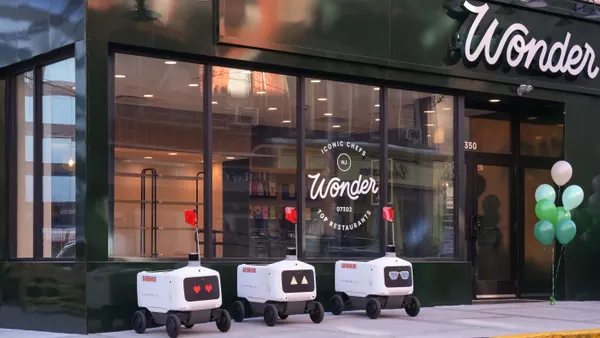Dive Brief:
- Del Taco's revenue and same-store sales growth slumped in its third quarter — results analysts have linked to declining traffic and increasing food and labor inflation. The Tex-Mex chain's revenue climbed 6.2% to $117.8 million in revenue, up from $100 million in the year-ago period, but missing Wall Street estimates of $120 million, according to a company release. Same-store sales inched up 1.4%, off from projections of 2% growth.
- Franchised locations continue to be a boon for the quick-service restaurant, with sales up 3%. By contrast, company-owned store sales grew less than a half-percent. The company slashed its 2018 fiscal guidance, lowering expected revenue to between $504 million and $507 million (previously $506 to $516 million) and total sales to between $470 million and $473 million (previously $473 to $478 million). The restaurant chain now anticipates 3% growth in same-store sales, compared to the 2% to 4% growth it had projected in July.
- Del Taco is launching a mobile app and will begin offering delivery in the Los Angeles area through Grubhub next month, and will offer delivery system-wide through Grubhub, Postmates and DoorDash. "We believe delivery will provide another convenient channel to enjoy our fresh, high quality food and that moving toward a multiple delivery service provider approach will position us to maximize consumer demand," CEO John D. Cappasola, Jr. said in the release.
Dive Insight:
Like many of its competitors, Del Taco is feeling the squeeze of food cost inflation and minimum wage hikes in its home state of California, which have dragged performance down. Still, the restaurant chain has enjoyed 20-straight quarters of comparable sales growth, and plans to open 13 to 16 new locations before the end of fiscal 2018.
The company is betting that its updated "Fresh Mexican Grill" branding will help drive healthier sales, a strategy that seems to be paying off. Consumers recently awarded Del Taco the top spot in the value category for Mexican chains — ahead of Taco Bell, Moe's, Chipotle and Qdoba — in Market Force Information's annual quick-service restaurant study. It also ranked sixth in overall customer rankings, about 10 points lower than Chipotle, but 10 points higher than Taco Bell.
It seems Del Taco is looking to fill a void in the Mexican fast food marketplace, combining freshly prepared foods and premium items with the speed, convenience and price offered by value-focused chains. Produce is all chopped in-house, and add-ons like fresh pico de gallo are made daily. New ads boast that its employees are "the hardest working hands in fast food," spotlighting real employees. It seems to be a savvy advertising strategy, as diners are increasingly interested in fresh, authentic meal solutions.
The restaurant is also throwing its money behind another consumer demand: delivery. With delivery through Grubhub, Postmates and DoorDash set to be available nationwide by 2019, Del Taco is shouldering its way into a crowded — but promising — new path to growth. Yum Brands, parent company of rival Taco Bell, partnered with Grubhub earlier this year, buying $200 million of the delivery company's stock to accelerate expansion.
Del Taco is also looking to drive sales by capturing more business after traditional dinner hours. As the gig economy heats up and older consumers work odd hours, late-night dining has become more commonplace. To cater to these night owls, the chain has swapped snack-sized items for larger portions on its late-night menu, aiming to attract a more sophisticated, higher-spending crowd after-hours. A quarter of Del Taco's business occurs between 8 p.m. and 6 a.m., with a hair over 5% between midnight and 4 a.m. Taco Bell's "fourth meals" during that same timeframe account for 7% of sales.
The chain has also doubled down on its value offerings, with a "Buck and Under" menu offering food starting at $0.69. Its made-fresh barbell menu strategy also lets customers opt for trade-ups such as fresh-grilled chicken and steak, positioning it as a more premium fast food provider. Whether or not the company's three-pronged growth strategy of delivery, freshness and value will be enough to get sales back on track, however, is an open question.










